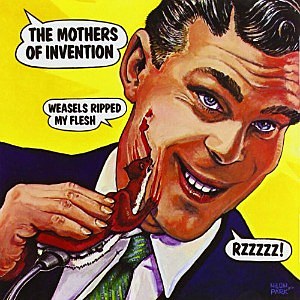
The Mothers of Invention were already in Frank’s rear view mirror when 1970′s Weasels Ripped My Flesh was released. He may have broken up the band in ’69, but Zappa was never one to waste a track; in fact, he had already released one posthumous Mothers album earlier that year, the classic Burnt Weeny Sandwich. Unlike its predecessor, Weasels contained both studio and live tracks, a strategy that he stuck with for the rest of recording career.
Zappa wasn’t one to waste much of anything, really: every sound, image, idea and contact went into that busy brain of his, waiting for the moment that it could be used. He was a composer in the truest sense of the word, rearranging the world around him into a unified artistic vision.
In terms of rock art, the artistic vision of the ’60s belonged not to Zappa’s Los Angeles but his hippy neighbors to the north. San Francisco in general and the Family Dog in particular created the visual style that most of us envision when we think of the psychedelic ’60s — those swirling fonts, contrasting neon colors and dazzling optical patterns. According to the book 100 Best Album Covers, Zappa took a liking to the work of Family Dog artist Neon Park, particularly the work he’d done for a band named Dancing Food. The input went into the aforementioned giant Zappa brain, and when the time came he asked Park to paint an album cover for him.
CURRENTLY AVAILABLE FROM GONZO
Frank Zappa is considered to be one of the most influential rock musicians of the late twentieth century. Between the start of his career in the late fifties and his death in 1993 he recorded and rele..
On September 19, 1985, Frank Zappa testified before the United States Senate Commerce, Technology, and Transportation committee, attacking the Parents Music Resource Center or PMRC, a music organizati..




No comments:
Post a Comment